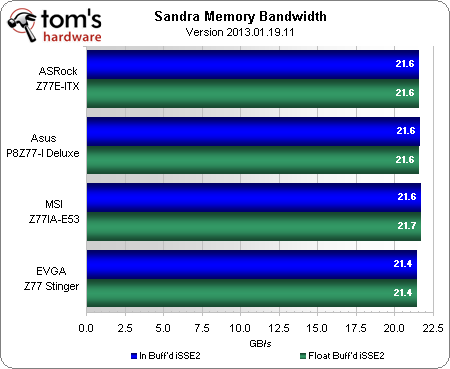Four Z77-Based Mini-ITX Motherboards, Reviewed
Features
By
Thomas Soderstrom
published
Yes, you can get all of the functionality enabled by Intel's Z77 Express chipset in a tiny mini-ITX form factor! We round up four motherboards that uniquely approach the gaming and media center markets with a range of features and prices. Which is best?
Add us as a preferred source on Google
Results: SiSoftware Sandra
ASRocks’ Z77E-ITX stands out in only one of the several Sandra CPU tests, appearing to have been boosted in a similar manner to Asus’ Multicore Enhancement BIOS option. Sandra doesn’t contribute to our overall performance averages, and this single metric is the only place where the Z77E-ITX performance stands out.
Stay On the Cutting Edge: Get the Tom's Hardware Newsletter
Get Tom's Hardware's best news and in-depth reviews, straight to your inbox.
Current page: Results: SiSoftware Sandra
Prev Page Results: 3DMark And PCMark Next Page Results: Battlefield 3 And F1 2012Thomas Soderstrom is a Senior Staff Editor at Tom's Hardware US. He tests and reviews cases, cooling, memory and motherboards.
37 Comments
Comment from the forums
-
where are the dtx mobos for those that want a gaming graphics card as well as a dedicated sound card that isnt onboard crap?Reply
-
tarkhein Asus maintains a list of other technologies only found on its platform, including the ability to charge smartphones and tablets through its USB portsReply
That technology is available from MSI and Asrock (and Gigabyte, but that's irrelevant in this roundup). Look up MSI i-Charger and Asrock App Charger. -
Crashman tarkheinAsus maintains a list of other technologies only found on its platform, including the ability to charge smartphones and tablets through its USB portsThat technology is available from MSI and Asrock (and Gigabyte, but that's irrelevant in this roundup). Look up MSI i-Charger and Asrock App Charger.All three companies have similar high-current charging features, but Asus extends them to non-Apple devices. The comment was originally left out due to the similarities and added later due to the differences.Reply
There was a big discussion between editors over whether or not the P8Z77-I Deluxe should get an award. The only award for "best features" is Tom's Hardware Approved, and that award is reserved for products that are clearly and obviously superior. The P8Z77-I Deluxe was a better board, but we had to look fairly hard to see it (it wasn't clear or obvious). -
Crashman amuffinSo many variations between each board when it comes to OC......LOL, welcome to Windows 8.Reply -
abbadon_34 "We retained most of the hardware from our previous Z77 motherboard round-ups, but were not able to reach the same CPU clock speeds. A shift over to Windows 8 was our biggest change, and services crashing under that operating system appeared to limit what we could achieve compared to Windows 7."Reply
CrashmanLOL, welcome to Windows 8.
How about using Windows 7? Was a reason you HAD to use 8 despite encountering issues? Is there some contractual obligation or monetary incentive to use the lastest version regardless of performance issues? Or at least test them both, it's only 4 motherboards. -
enewmen I think Mini-ITX will be the new standard size.Reply
It's not like the 80s/90s where you needed a full size AT/ATX motherboard with many slots for the ST-506 controller, floppy disk controller, serial port, parallel port, Sound Blaster card, VGA card, token ring card, and an extra cooling fan.
EDIT:
I will later get a Mini-ITX later & Silverstone case, stick in a Noctua NH-C12P & Haswell i7, and my Nv 680. That will have very high power density and worthy of being my "main" PC. (and it will OC) -
abbadon_34 One issue I see is the PCI-E x16 slot is at the very bottom of these boards, and most video cards use two slots, requiring a larger case than one that simply supporting the motherboard based on ITX/mini-ITX dimensions. I'd be interesting in exploring the limitations of such configurations, and whether these boards are effectively limited to single slot video cards (and performance), require larger cases than is assumed, or specific case configurations.Reply -
Crashman abbadon_34Was a reason you HAD to use 8 despite encountering issues?Standardization. The thought of having a spare drive on hand simply for testing O/C never even crossed my mind after hearing the "s" word.abbadon_34One issue I see is the PCI-E x16 slot is at the very bottom of these boards, and most video cards use two slots, requiring a larger case than one that simply supporting the motherboard based on ITX/mini-ITX dimensions. I'd be interesting in exploring the limitations of such configurations, and whether these boards are effectively limited to single slot video cards (and performance), require larger cases than is assumed, or specific case configurations.It's called DTX, it's mentioned in the article's FIRST paragraph, and Tom's Hardware even has DTX case reviews. Since most people don't know what DTX is, most case manufacturers have changed the label to read "Mini ITX". Still, there are a bunch of DTX cases out there caring the Mini ITX label.Reply



